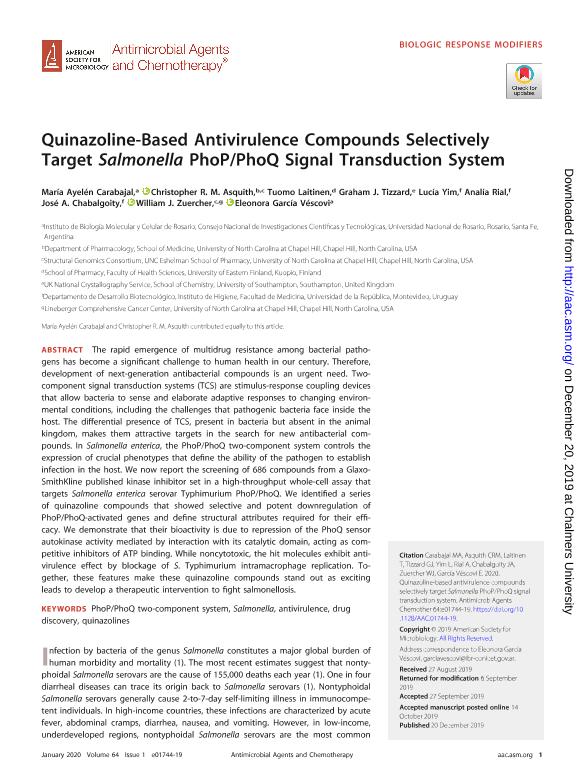Mostrar el registro sencillo del ítem
dc.contributor.author
Carabajal, María Ayelén

dc.contributor.author
Asquith, Christopher R. M.
dc.contributor.author
Laitinen, Tuomo
dc.contributor.author
Tizzard, Graham J.
dc.contributor.author
Yim, Lucía
dc.contributor.author
Rial, Analía
dc.contributor.author
Chabalgoity, José A.
dc.contributor.author
Zuercher, William J.
dc.contributor.author
Garcia Vescovi, Eleonora

dc.date.available
2022-12-27T14:57:38Z
dc.date.issued
2019-12
dc.identifier.citation
Carabajal, María Ayelén; Asquith, Christopher R. M.; Laitinen, Tuomo; Tizzard, Graham J.; Yim, Lucía; et al.; Quinazoline-Based Antivirulence Compounds Selectively Target Salmonella PhoP/PhoQ Signal Transduction System; American Society for Microbiology; Antimicrobial Agents and Chemotherapy; 64; 1; 12-2019; 1-16
dc.identifier.issn
0066-4804
dc.identifier.uri
http://hdl.handle.net/11336/182537
dc.description.abstract
The rapid emergence of multidrug resistance among bacterial pathogens has become a significant challenge to human health in our century. Therefore, development of next-generation antibacterial compounds is an urgent need. Two-component signal transduction systems (TCS) are stimulus-response coupling devices that allow bacteria to sense and elaborate adaptive responses to changing environmental conditions, including the challenges that pathogenic bacteria face inside the host. The differential presence of TCS, present in bacteria but absent in the animal kingdom, makes them attractive targets in the search for new antibacterial compounds. In Salmonella enterica, the PhoP/PhoQ two-component system controls the expression of crucial phenotypes that define the ability of the pathogen to establish infection in the host. We now report the screening of 686 compounds from a GlaxoSmithKline published kinase inhibitor set in a high-throughput whole-cell assay that targets Salmonella enterica serovar Typhimurium PhoP/PhoQ. We identified a series of quinazoline compounds that showed selective and potent downregulation of PhoP/PhoQ-activated genes and define structural attributes required for their efficacy. We demonstrate that their bioactivity is due to repression of the PhoQ sensor autokinase activity mediated by interaction with its catalytic domain, acting as competitive inhibitors of ATP binding. While noncytotoxic, the hit molecules exhibit antivirulence effect by blockage of S. Typhimurium intramacrophage replication. Together, these features make these quinazoline compounds stand out as exciting leads to develop a therapeutic intervention to fight salmonellosis.
dc.format
application/pdf
dc.language.iso
eng
dc.publisher
American Society for Microbiology

dc.rights
info:eu-repo/semantics/openAccess
dc.rights.uri
https://creativecommons.org/licenses/by-nc-sa/2.5/ar/
dc.subject
ANTIVIRULENCE
dc.subject
DRUG DISCOVERY
dc.subject
PHOP/PHOQ TWO-COMPONENT SYSTEM
dc.subject
QUINAZOLINES
dc.subject
SALMONELLA
dc.subject.classification
Biología Celular, Microbiología

dc.subject.classification
Ciencias Biológicas

dc.subject.classification
CIENCIAS NATURALES Y EXACTAS

dc.title
Quinazoline-Based Antivirulence Compounds Selectively Target Salmonella PhoP/PhoQ Signal Transduction System
dc.type
info:eu-repo/semantics/article
dc.type
info:ar-repo/semantics/artículo
dc.type
info:eu-repo/semantics/publishedVersion
dc.date.updated
2020-11-25T17:56:31Z
dc.journal.volume
64
dc.journal.number
1
dc.journal.pagination
1-16
dc.journal.pais
Estados Unidos

dc.journal.ciudad
Washington
dc.description.fil
Fil: Carabajal, María Ayelén. Consejo Nacional de Investigaciones Científicas y Técnicas. Centro Científico Tecnológico Conicet - Rosario. Instituto de Biología Molecular y Celular de Rosario. Universidad Nacional de Rosario. Facultad de Ciencias Bioquímicas y Farmacéuticas. Instituto de Biología Molecular y Celular de Rosario; Argentina
dc.description.fil
Fil: Asquith, Christopher R. M.. University of North Carolina; Estados Unidos
dc.description.fil
Fil: Laitinen, Tuomo. University of North Carolina; Estados Unidos
dc.description.fil
Fil: Tizzard, Graham J.. University of North Carolina; Estados Unidos
dc.description.fil
Fil: Yim, Lucía. Universidad de la República; Uruguay
dc.description.fil
Fil: Rial, Analía. Universidad de la República; Uruguay
dc.description.fil
Fil: Chabalgoity, José A.. Universidad de la República; Uruguay
dc.description.fil
Fil: Zuercher, William J.. University of North Carolina; Estados Unidos
dc.description.fil
Fil: Garcia Vescovi, Eleonora. Consejo Nacional de Investigaciones Científicas y Técnicas. Centro Científico Tecnológico Conicet - Rosario. Instituto de Biología Molecular y Celular de Rosario. Universidad Nacional de Rosario. Facultad de Ciencias Bioquímicas y Farmacéuticas. Instituto de Biología Molecular y Celular de Rosario; Argentina
dc.journal.title
Antimicrobial Agents and Chemotherapy

dc.relation.alternativeid
info:eu-repo/semantics/altIdentifier/url/https://aac.asm.org/content/64/1/e01744-19
dc.relation.alternativeid
info:eu-repo/semantics/altIdentifier/doi/http://dx.doi.org/10.1128/AAC.01744-19
Archivos asociados
